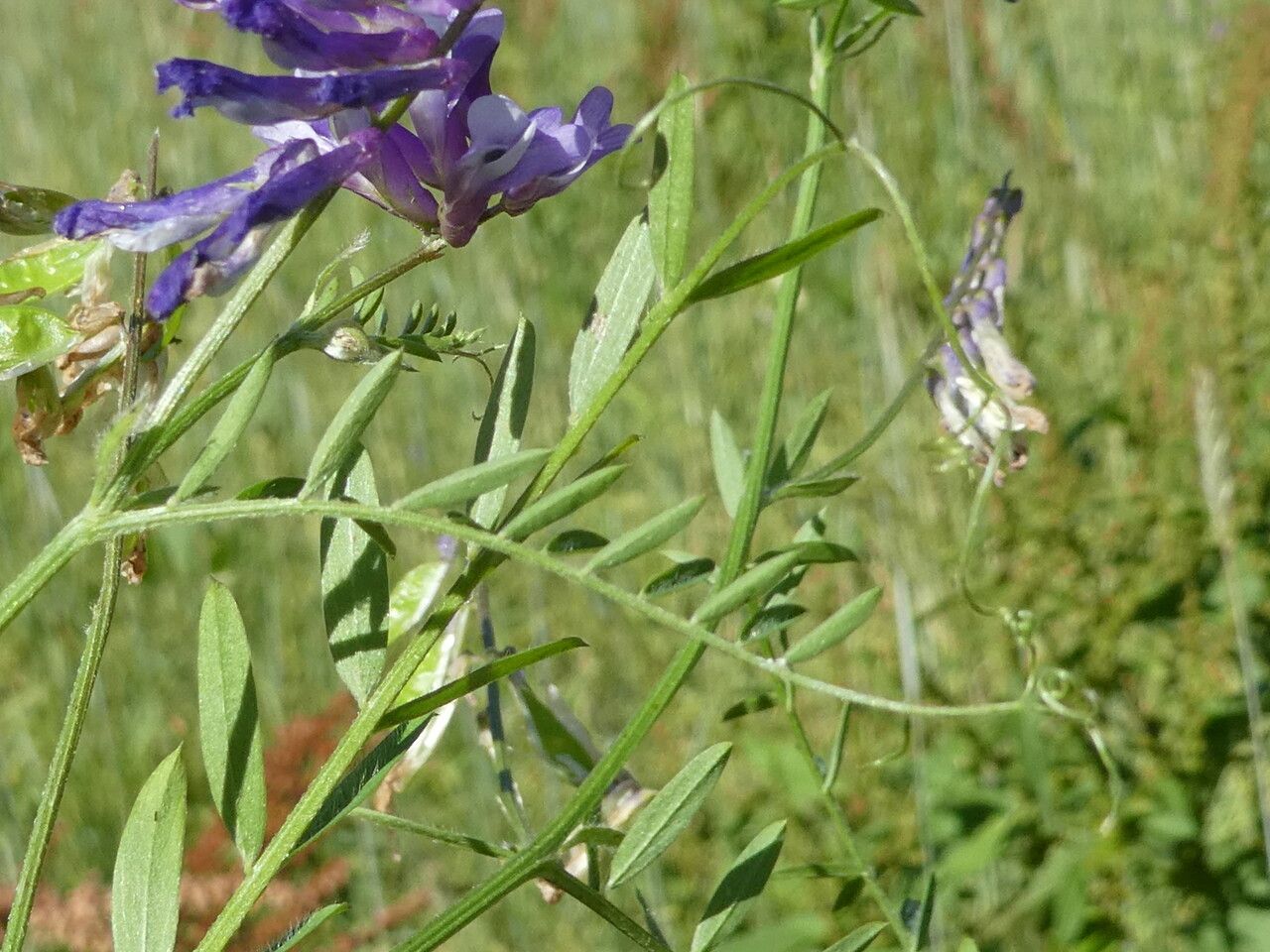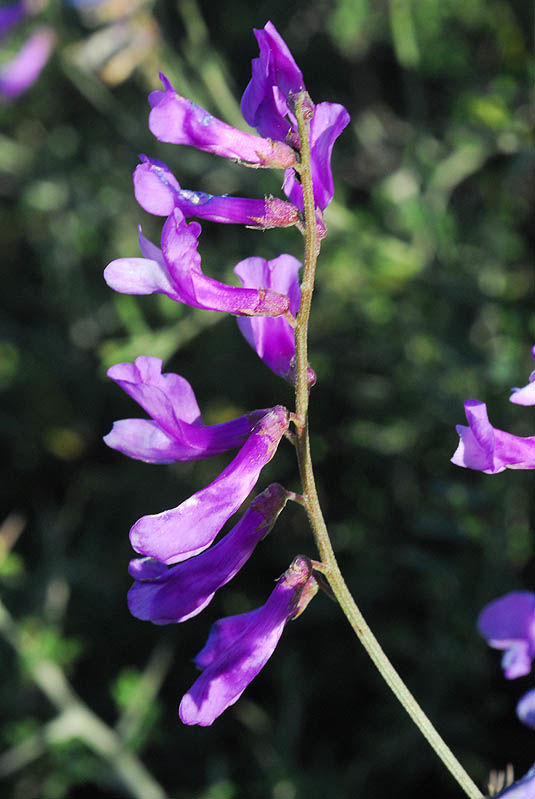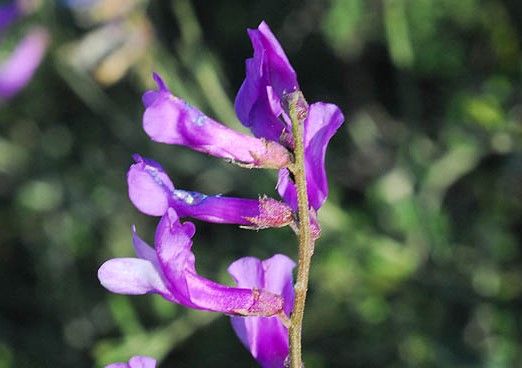Fine-leaved Vetch
vicia tenuifolia
Also known as: ["Slender Vetch","Narrow-leaved Vetch"]
Overview
A perennial herbaceous plant with fine, delicate leaves and pea-like flowers, often found in grasslands and meadows.
Benefits & Perks
["wildlife attractant (bees, butterflies, birds)","drought tolerant","shade tolerant"]
Botanical Classification
| Phylum: | Magnoliophyta |
| Class: | Magnoliopsida |
| Order: | Fabales |
| Family: | Fabaceae |
| Genus: | Vicia |
| Botanical Name: | Vicia tenuifolia |
Plant Characteristics
Basic Information
- Category: Herbs & Weeds
- Suitable Location: garden bed or container in a location with good air circulation
- Suitable For:
- Is Weed: No
- Allergenicity: low
Environmental Needs
- Climate: {"temperatureRange":"5–30°C"}
- Hardiness: {"zones":"4–8"}
- Misting: rarely required, only if ambient humidity is very low
- Drainage: Fast-draining to prevent waterlogging.
- Soil Type: Well-draining, loamy soil with added organic matter; suitable for raised beds or containers.
Maintenance Level
- Maintenance Level: low
- Toughness Level: moderate
- Pruning Frequency: As needed, typically every 2–3 months or after flowering to remove spent blooms.
- Pruning Intensity: Light to moderate; avoid heavy pruning unless necessary to control size or shape.
Care Details
Ideal Sunlight Coverage:
Full sun to partial shade; 6–8 hours of direct sunlight per day, with some afternoon shade in hot climates to prevent scorching.
Sunlight Tolerance Tips:
Acclimate plants gradually to intense sunlight; provide shade during peak afternoon hours in hot regions; adjust placement based on seasonal light changes.
Care Requirements
Care Difficulty
easyModerate
Sunlight
full sun to partial shade
Rotate plants weekly for even growth; use sheer curtains to filter intense light indoors; monitor for signs of sunburn or etiolation.
Watering
every 7–10 days during active growth, reduce in winter
Water thoroughly until it drains from the bottom, allow soil to dry between waterings, avoid wetting foliage to prevent fungal issues.
Soil
well-drained, loamy soil with moderate organic content
pH: Slightly acidic to neutral (pH 6.0–7.0).
Ensure good drainage to prevent root rot; amend with organic matter for fertility; monitor pH levels periodically.
Temperature
Prefers cool to moderate temperatures, ideally 60–75°F (15–24°C); tolerates cooler nights but avoids prolonged frost.
Monitor temperature fluctuations; protect from sudden cold snaps; adjust watering based on temperature changes.
Fertilizing
every 4–6 weeks during growing season with balanced liquid fertilizer
Apply fertilizer to moist soil to prevent root burn; flush soil occasionally to prevent salt buildup; reduce feeding for established plants.
Propagation
Methods
Stem cuttings or division; stem cuttings are the most common method for Vicia tenuifolia.
Step-by-Step Propagation Guide
- Take 4–6 inch cuttings with at least two nodes.
- Remove lower leaves.
- Dip in rooting hormone.
- Plant in moist medium.
- Maintain humidity.
- Water lightly until roots form.
Best Time: Spring or early summer when the plant is actively growing.
Environment
High humidity (70–90%), warm temperatures (65–75°F), and indirect light for cuttings; similar conditions for division.
Medium
Well-draining potting mix with perlite or sand for cuttings; moist peat moss for division.
Hormone
Rooting hormone is recommended to encourage faster root development.
Timeline
Cuttings may root in 3–6 weeks; division can establish more quickly if roots are well-developed.
Tools Needed
Sharp pruners, rooting hormone, small pots, misting spray bottle, plastic bags or propagation dome.
Quick Tips
Use clean tools to prevent disease; maintain consistent moisture; provide gentle bottom heat for faster rooting.
Pruning & Repotting
Pruning Guide
Method
Pinch back tips to encourage branching; trim back leggy stems; remove dead or yellowing leaves.
Pruning Plan
Prune to maintain shape, encourage bushier growth, and remove dead or diseased parts; light pruning is usually sufficient for Vicia tenuifolia.
Tools
Clean, sharp pruning shears or scissors.
Checklist
Use clean tools; prune during active growth; remove dead or diseased parts; shape as desired.
Repotting Guide
Best Season
Early spring before new growth begins.
Pot Size
One size up from the current pot (e.g., +2 inches in diameter).
Method
Gently remove the plant; trim any circling roots; place in a slightly larger pot with fresh, well-draining soil; water thoroughly after repotting.
Suggestions
Repot every 2–3 years or when roots fill the pot; beneficial for container-grown plants to refresh soil and provide space.
Checklist
Choose a clean pot with drainage holes; use fresh soil mix; handle roots gently; water after repotting; place in a shaded area for a few days.
Advanced Care Tips
Watering Mastery
Watering Checklist
Check soil moisture before watering; water deeply at the base; ensure proper drainage; avoid overhead watering.
How to Apply Water Properly
Water directly at the base of the plant, ensuring moisture reaches the root zone; water early in the morning to minimize evaporation and fungal growth; ensure excess water drains away to prevent waterlogging.
Watering Schedule Tips
Water deeply once the top inch of soil feels dry; reduce frequency in winter to prevent root rot.
Soil Improvement
Add compost or well-rotted manure for fertility; incorporate perlite or sand for drainage; use mulch to retain moisture and improve soil structure.
Temperature Stress Management
Signs of Temperature Issues
Wilting, yellowing leaves, stunted growth, or bud drop in extreme heat or cold; leaf scorch or browning in excessive sunlight.
Cold Stress
Low temperatures slow growth and can cause root damage or dieback; prolonged frost may kill tender parts of the plant.
Solution: Provide frost protection with row covers or mulch; move potted plants indoors or to a sheltered location; avoid overwatering in cold conditions.
Hot Stress
Excessive heat can lead to wilting, leaf scorch, and reduced flowering; heat stress may cause the plant to go dormant.
Solution: Provide shade during peak heat; increase watering frequency to keep soil moist; use mulch to retain soil moisture and cool roots.
Fertilizing Guide
Fertilizing Checklist
Use diluted fertilizer; apply during active growth; avoid winter feeding; flush soil periodically.
Fertilizing Method
Use a balanced, water-soluble fertilizer diluted to half strength every 4–6 weeks during the growing season (spring to early fall); avoid fertilizing in winter.
Common Problems & Solutions
Toxicity Warning
Cats
Slightly ToxicCats may experience mild gastrointestinal symptoms if they ingest Vicia tenuifolia. The alkaloids present can cause mild irritation to the digestive tract.
⚠️ Symptoms:
🌿 Toxic Parts:
⚡ Toxic If:
if eaten
Dogs
Slightly ToxicIn dogs, ingestion of Vicia tenuifolia can lead to mild gastrointestinal upset due to the presence of alkaloids. The effects are typically not severe but can cause discomfort.
⚠️ Symptoms:
🌿 Toxic Parts:
⚡ Toxic If:
if eaten
Humans
Slightly ToxicVicia tenuifolia contains alkaloids that can cause mild gastrointestinal distress and other mild symptoms upon ingestion. The physiological impact is generally limited to the digestive system.
⚠️ Symptoms:
🌿 Toxic Parts:
⚡ Toxic If:
if eaten
Frequently Asked Questions
Q: Is Vicia tenuifolia toxic to pets?
A: It is mildly toxic to dogs and cats.
Q: Does this plant attract wildlife?
A: Yes, it attracts bees, butterflies, and birds.
Q: Is it suitable for beginners?
A: Yes, it is easy to care for and requires low maintenance.
Quick Reference
| Family: | Fabaceae |
| Care: | easy |
| Light: | full sun to partial shade |
| Water: | every 7–10 days during activ |
Get Expert Care Tips
Download the Plantious app for personalized care reminders and plant identification!
Google Play App Store








